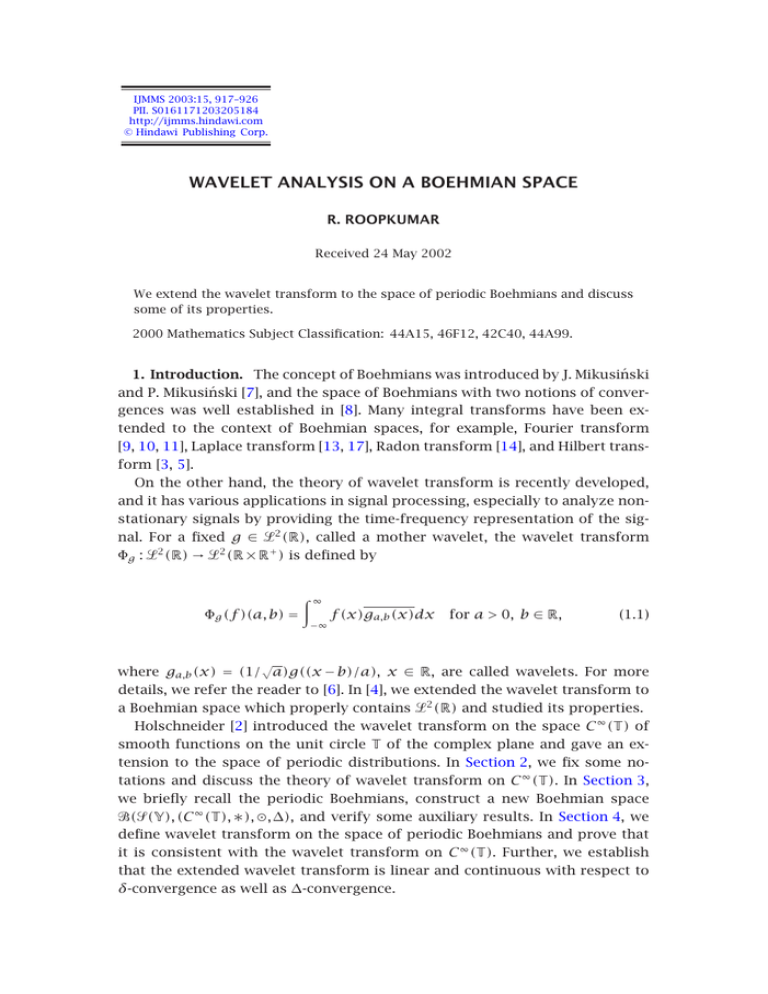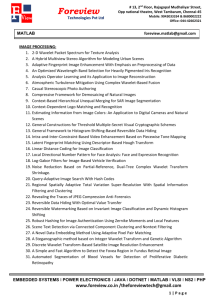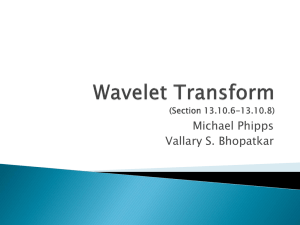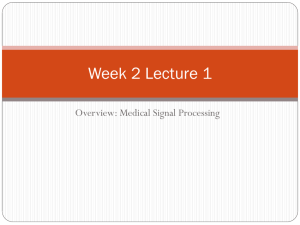WAVELET ANALYSIS ON A BOEHMIAN SPACE R. ROOPKUMAR
advertisement

IJMMS 2003:15, 917–926
PII. S0161171203205184
http://ijmms.hindawi.com
© Hindawi Publishing Corp.
WAVELET ANALYSIS ON A BOEHMIAN SPACE
R. ROOPKUMAR
Received 24 May 2002
We extend the wavelet transform to the space of periodic Boehmians and discuss
some of its properties.
2000 Mathematics Subject Classification: 44A15, 46F12, 42C40, 44A99.
1. Introduction. The concept of Boehmians was introduced by J. Mikusiński
and P. Mikusiński [7], and the space of Boehmians with two notions of convergences was well established in [8]. Many integral transforms have been extended to the context of Boehmian spaces, for example, Fourier transform
[9, 10, 11], Laplace transform [13, 17], Radon transform [14], and Hilbert transform [3, 5].
On the other hand, the theory of wavelet transform is recently developed,
and it has various applications in signal processing, especially to analyze nonstationary signals by providing the time-frequency representation of the signal. For a fixed g ∈ ᏸ2 (R), called a mother wavelet, the wavelet transform
Φg : ᏸ2 (R) → ᏸ2 (R × R+ ) is defined by
Φg (f )(a, b) =
∞
−∞
f (x)ga,b (x)dx
for a > 0, b ∈ R,
(1.1)
√
where ga,b (x) = (1/ a)g((x − b)/a), x ∈ R, are called wavelets. For more
details, we refer the reader to [6]. In [4], we extended the wavelet transform to
a Boehmian space which properly contains ᏸ2 (R) and studied its properties.
Holschneider [2] introduced the wavelet transform on the space C ∞ (T) of
smooth functions on the unit circle T of the complex plane and gave an extension to the space of periodic distributions. In Section 2, we fix some notations and discuss the theory of wavelet transform on C ∞ (T). In Section 3,
we briefly recall the periodic Boehmians, construct a new Boehmian space
Ꮾ((Y), (C ∞ (T), ∗), , ∆), and verify some auxiliary results. In Section 4, we
define wavelet transform on the space of periodic Boehmians and prove that
it is consistent with the wavelet transform on C ∞ (T). Further, we establish
that the extended wavelet transform is linear and continuous with respect to
δ-convergence as well as ∆-convergence.
918
R. ROOPKUMAR
2. Preliminaries. The space C ∞ (T) consists of infinitely differentiable, periodic functions on R of period 2π , with the Fréchet space topology induced
by the increasing sequence of seminorms
φC ∞ (T);n =
n
sup ∂ p φ(t).
(2.1)
p=0 t∈[0,2π ]
We know that
C ∞ (T) = C+∞ (T) ⊕ C−∞ (T) ⊕ K(T),
(2.2)
where C+∞ (T) and C−∞ (T) are the subspaces consisting of functions with positive and negative Fourier coefficients, respectively, and K(T) is the space of
constant functions.
Let (R) denote the space of rapidly decreasing functions on R. (See [1].)
Given f ∈ (R), b ∈ [0, 2π ], and a > 0, define fa , fb,a ∈ C ∞ (T) by
fa (x) =
1 x + 2nπ f
,
a
a
n∈Z
fb,a (x) = fa (x − b),
x ∈ [0, 2π ],
(2.3)
x ∈ [0, 2π ].
Let (Y) denote the Fréchet space of all smooth functions η(b, a) of rapid
descent on R×R+ which are periodic functions in the variable b of period 2π ,
with the following directed family of seminorms:
η(Y);n,α,β =
sup sup ap ∂al ∂bk η(b, a).
(2.4)
0≤p≤n a>0 b∈[0,2π ]
0≤l≤α
0≤k≤β
We choose a mother wavelet g ∈ (R) with all moments
equal to zero.
∞
−∞ x
n
g(x)dx are
Definition 2.1. The wavelet transform Tg : C ∞ (T) → (Y) is defined by
2π
Tg (φ) =
0
φ(x)gb,a (x)dx,
b ∈ R, a > 0.
(2.5)
Theorem 2.2. The wavelet transform Tg : C ∞ (T) → (Y) is continuous and
linear.
Definition 2.3. The map Rg : (Y) → C ∞ (T) is defined by
Rg η (x) =
2π ∞
0
0
gb,a (x)η(b, a)
dadb
.
a
(2.6)
WAVELET ANALYSIS ON A BOEHMIAN SPACE
919
Theorem 2.4. The map Rg : (Y) → C ∞ (T) is continuous and linear.
A partial inversion formula is given by the following theorem.
∞
Theorem 2.5. If ĝ is the Fourier transform of g and Cg+ = 0 |ĝ(a)|2 (da/a),
∞
Cg− = 0 |ĝ(−a)|2 (da/a), then
Rg ◦ Tg φ = Cg+ φ,
∀φ ∈ C+∞ (T),
Rg ◦ Tg φ = Cg− φ,
∀φ ∈ C−∞ (T).
(2.7)
3. Boehmian spaces. The triplet (C ∞ (T), ∗, ∆), where ∗ : C ∞ (T) × C ∞ (T) →
C (T) is defined by
∞
2π
(φ ∗ ψ)(x) =
0
φ(x − t)ψ(t)dt,
x ∈ [0, 2π ]
(3.1)
and ∆ is the collection of all sequences (δk ) from C ∞ (T) satisfying
2π
(1) 0 δk (t)dt = 1 for all k ∈ N,
2π
(2) 0 |δk (t)|dt ≤ M for all k ∈ N, for some M > 0,
(3) s(δk ) → 0 as n → ∞ where s(δk ) = sup{t ∈ [0, 2π ] : δk (t) = 0},
is the collection of all equivalence classes [φk /δk ] given by the equivalence
relation ∼ defined by
if φk ∗ j = ψj ∗ δk ∀k, j ∈ N
φk , δk ∼ ψk , k
(3.2)
on the collection Ꮽ of pair of sequences ((φk ), (δk )), φn ∈ C ∞ (T), (δk ) ∈ ∆
satisfying
φk ∗ δj = φj ∗ δk ,
∀k, j ∈ N.
(3.3)
This triplet with addition and scalar multiplication, defined by
φk
ψk
φk ∗ k + ψk ∗ δk
+
=
,
δk
k
δk ∗ k
αφk
φk
=
,
α
δk
δk
(3.4)
is called the periodic Boehmian space [15, 16], and we denote it by ᏮT .
Definition 3.1 (δ-convergence). A sequence (xn ) δ-converges to x in
δ
ᏮT , denoted by xn →
x as n → ∞ in ᏮT if there exists (δk ) ∈ ∆ such that
920
R. ROOPKUMAR
xn ∗ δk , x ∗ δk ∈ C ∞ (T), and for each k ∈ N,
as n → ∞ in C ∞ (T).
xn ∗ δk → x ∗ δk
(3.5)
The following theorem is proved in [8].
δ
x as n → ∞ in ᏮT if and only
Theorem 3.2. Let xn , x ∈ ᏮT , n ∈ N. xn →
if there exist φn,k , φk ∈ C ∞ (T) such that xn = [φn,k /δk ], [φk /δk ] and, for each
k ∈ N,
φn,k → φk
as n → ∞ in C ∞ (T).
(3.6)
Definition 3.3 (∆-convergence). A sequence (xn ) ∆-converges to x in ᏮT ,
∆
x as n → ∞ in ᏮT if there exists a delta-sequence (δn ) such
denoted by xn →
that (xn − x) ∗ δn ∈ C ∞ (T) for each n ∈ N and
xn − x ∗ δn → 0
as n → ∞ in C ∞ (T).
(3.7)
Now, we construct a new Boehmian space as follows.
As in the context of Boehmian space defined in [12], we take the vector space
Γ and the commutative semi-group as (Y) and (C ∞ (T), ∗), respectively.
Definition 3.4. Given η ∈ (Y) and φ ∈ C ∞ (T), define
2π
(η φ)(b, a) =
0
η(b − t, a)φ(t)dt.
(3.8)
Lemma 3.5. If η ∈ (Y) and φ ∈ C ∞ (T), then η φ ∈ (Y).
Proof. To prove that (ηφ)(b, a) is infinitely differentiable, we show that
∂a (η φ)(b, a) = ∂a η φ (b, a),
∂b (η φ)(b, a) = ∂b η φ (b, a).
(3.9)
Fix a0 > 0, b0 ∈ R arbitrarily.
2π
Consider ((η φ)(b0 , a) − (η φ)(b0 , a0 ))/(a − a0 ) = 0 (η(b0 − t, a) −
η(b0 − t, a0 ))/(a − a0 )φ(t)dt. Using the mean-value theorem (in the variable
a), we get that the integrand is dominated by η(Y);0,1,0 φC ∞ (T),0 . Therefore,
we can apply Lebesgue dominated convergence theorem [18], and we get
η b0 − t, a − η b0 − t, a0
φ(t)dt
a→a0 0
a − a0
2π
η b0 − t, a − η b0 − t, a0
=
lim
φ(t)dt
a − a0
0 a→a0
2π
∂a η b0 − t, a0 φ(t)dt
=
0
= ∂a η φ b0 , a0 .
∂a (η φ) b0 , a0 = lim
2π
(3.10)
921
WAVELET ANALYSIS ON A BOEHMIAN SPACE
By a similar argument, we can prove that ∂b (η φ)(b, a) = (∂b η φ)(b, a).
Finally by a routine manipulation, we get
η φ(Y);n,α,β ≤ φᏸ1 (T) η(Y);n,α,β ,
where φᏸ1 (T) =
2π
0
(3.11)
|φ(t)|dt. Hence, η φ ∈ (Y).
Lemma 3.6. If η ∈ (Y) and (δn ) ∈ ∆, then η δn → φ as n → ∞ in (Y).
Proof. Let p, k, l ∈ N0 be arbitrary. Using the mean-value theorem and a
property of δ-sequence, we get
p l k
a ∂ ∂ η δn − η (b, a) = ap ∂ l ∂ k η δn (b, a) − ap ∂ l ∂ k η(b, a)
a b
2π
≤
0
a b
a b
p l k
a ∂ ∂ η(b − t, a) − ∂ l ∂ k η(b, a) δn (t)dt
a b
a b
2π
≤ η(Y);p,l,k+1
|t|δn (t)dt
0
≤ Ms δn η(Y);p,l,k+1 ,
(3.12)
which tends to 0 as n → ∞. This completes the proof of the lemma.
Lemma 3.7. If ηn → η as n → ∞ in (Y) and ψ ∈ C ∞ (T), then ηn ψ → ηψ
as n → ∞.
Proof. Let p, k, l ∈ N0 be arbitrary. Now,
p l k
a ∂ ∂ ηn ψ − η ψ (b, a)
a b
2π
ap ∂al ∂bk ηn − η (b, a)ψ(t)dt
0
≤ ψᏸ1 (T) ηn − η(Y);p,l,k → 0 as n → ∞.
≤
(3.13)
Hence, the lemma follows.
Lemma 3.8. If ηn → η as n → ∞ in (Y) and δn ∈ ∆, then ηn δn → η as
n → ∞.
Proof. Since we have ηn δn − η = ηn δn − η δn + η δn − η and
Lemma 3.6, we merely prove that ηn δn − η δn → 0 as n → ∞.
If p, k, l ∈ N0 , then, using a property of delta-sequence, we get
p l k
a ∂ ∂ ηn − η δn (b, a)
a b
≤ ηn − η(Y);p,l,k
2π
0
δn (t)dt ≤ M ηn − η
The above inequalities prove the lemma.
(3.14)
(Y);p,l,k .
922
R. ROOPKUMAR
Now using the above lemmas we can construct the Boehmian space ᏮY =
(Y , (C ∞ , ∗), , ∆) in a canonical way.
4. Generalized wavelet transform
Definition 4.1. Define ᐀g : ᏮT → ᏮY by
᐀g
φn
δn
=
T g φn
.
δn
(4.1)
Theorem 4.2. The generalized wavelet transform ᐀g : ᏮT → ᏮY is well defined.
First, we state and prove a lemma that will be useful.
Lemma 4.3. If φ, ψ ∈ C ∞ (T), then Tg (φ ∗ ψ) = Tg φ ψ.
Proof. Let a ∈ R+ and b ∈ R be arbitrary. Now
2π
Tg (φ ∗ ψ)(b, a) =
0
2π
=
0
(φ ∗ ψ)(x)ga (x − b)dx
(4.2)
2π
ga (x − b)dx
0
φ(x − t)ψ(t)dt.
By an easy verification, we can apply Fubini’s theorem and the last integral
equals
2π
2π
ψ(t)dt
0
2π
0
φ(x − t)ga (x − b)dx
2π
ψ(t)dt
φ(x)ga x − (b − t) dx
0
0
= Tg φ ψ (b, a).
=
(4.3)
Proof of Theorem 4.2. First, we show that ((Tg φn ), (δn )) is a quotient.
Since [φn /δn ] ∈ ᏮT , we have
φk ∗ δj = φj ∗ δk ,
∀j, k ∈ N.
(4.4)
Applying the classical wavelet transform Tg on both sides, we get
Tg φk δj = Tg φj φk ,
∀j, k ∈ N (by Lemma 4.3).
(4.5)
Next, we show that the definition of ᐀g is independent of the choice of the
representative.
WAVELET ANALYSIS ON A BOEHMIAN SPACE
923
Let [φk /k ] = [ψk /δk ] in ᏮT . Then, we have
φk ∗ j = ψj ∗ δk ,
∀j, k ∈ N.
(4.6)
Again, applying the wavelet transform and using Lemma 4.3, we get
᐀g φk j = ᐀g ψj δk ,
∀j, k ∈ N.
(4.7)
Hence, the theorem follows.
Theorem 4.4 (consistency). Let ᏵT : C ∞ (T) → ᏮT and ᏵY : (Y) → ᏮY be the
canonical identification defined, respectively, by
φ →
φ ∗ δn
,
δn
η →
η δn
,
δn
(4.8)
where (δn ) ∈ ∆, then ᐀g ◦ ᏵT = ᏵY ◦ Tg .
Proof. Let φ ∈ C ∞ (T), then
Tg φ ∗ δn
φ ∗ δn
=
δn
δn
Tg φ δn
(by Lemma 4.3)
=
δn
= ᏵY Tg (φ) .
᐀g ᏵT (φ) = ᐀g
(4.9)
Theorem 4.5. The wavelet transform ᐀g : ᏮT → ᏮY is a linear map.
Proof. If [φn /δn ], [ψn /n ] ∈ ᏮT , then
᐀g
Tg φn ∗ n + ψn ∗ δn
φn
ψn
φn ∗ n + ψn ∗ δn
+
= ᐀g
=
δn
n
δn ∗ n
δn ∗ n
Tg φn n + Tg ψn δn
T g φn
Tg ψn
=
=
+
δn ∗ n
δn
n
φn
ψn
+ ᐀g
.
= ᐀g
δn
n
(4.10)
If α ∈ C and [φn /δn ] ∈ ᏮT , then
Tg αφn
αTg φn
φn
αφn
᐀g α
= ᐀g
=
=
δn
δn
δn
δn
T g φn
φn
=α
= α᐀g
.
δn
δn
(4.11)
In the above proof, we have used the fact that Tg is linear wherever it is
required.
924
R. ROOPKUMAR
From the following two theorems, we say that the generalized wavelet transform is continuous with respect to δ-convergence as well as ∆-convergence.
δ
δ
x as n → ∞ in ᏮT , then ᐀g xn →
᐀g x as n → ∞ in
Theorem 4.6. If xn →
ᏮY .
δ
Proof. If xn →
x as n → ∞, then, by Theorem 3.2, there exist φn,k , φk ∈
C ∞ (T) and (δk ) ∈ ∆ such that xn = [φn,k /δk ] and x = [φk /δk ] and, for each
k ∈ N, φn,k → φk as n → ∞ in C ∞ (T).
By the continuity of the classical wavelet transform, we have, for each k ∈ N,
Tg φn,k → Tg φk
as n → ∞ in Y .
(4.12)
δ
Since ᐀g (xn ) = [Tg φn,k /δk ] and ᐀g (x) = [Tg φk /δk ], we get ᐀g (xn ) →
᐀g (x)
as n → ∞. Hence, the theorem follows.
∆
∆
Theorem 4.7. If xn →
x as n → ∞ in ᏮT , then ᐀g xn →
᐀g x as n → ∞ in
ᏮY .
∆
Proof. Let xn →
x as n → ∞ in ᏮT . Then, by definition, we can find φn ∈
C ∞ (T) and (δn ) ∈ ∆ such that (xn − x) ∗ δn = [φn ∗ δk /δk ] and
as n → 0 in C ∞ (T).
φn → 0
(4.13)
Applying the classical wavelet transform and using Lemma 4.3, we get
as n → 0 in (Y).
Tg φn → 0
(4.14)
∆
Hence, we get ᐀g xn →
᐀g x as n → ∞ in ᏮY .
Lemma 4.8. If η ∈ (Y) and φ ∈ C ∞ (T), then Rg (η φ) = Rg η ∗ φ.
Proof. Using Fubini’s theorem, we get
Rg (η φ)(x) =
=
2π ∞
0
0
2π
=
=
0
2π ∞
0
ga (x − b)(η φ)(b, a)
ga (x − b)
dadb
a
2π ∞
φ(t)dt
0
2π
0
2π
0
∞
0
0
φ(t)dt
0
2π
2π
0
dadb
a
η(b − t, a)φ(t)dt
ga (x − b)η(b − t, a)
dadb
a
dadc
ga (x − t) − c η(c, a)
a
(b − t = c)
=
Rg η(x − t)φ(t)dt
0
= Rg η ∗ φ (x).
(4.15)
WAVELET ANALYSIS ON A BOEHMIAN SPACE
925
Therefore, we can give the following definition.
Definition 4.9. Define g : ᏮY → ᏮT by
g
ηn
δn
=
R g ηn
.
δn
(4.16)
Theorem 4.10. The map g : ᏮY → ᏮT is linear.
Theorem 4.11. The map g : ᏮY → ᏮT is continuous with respect to δconvergence as well as ∆-convergence.
Using Lemma 4.8 and Theorem 2.4, we get a proof similar to that of Theorems 4.6 and 4.7.
Theorem 4.12 (an inversion formula). If x = [φn /δn ] ∈ ᏮT such that φn ∈
∞
(T) for all n ∈ N, then
C+(−)
g ◦ ᐀g (x) = Cg+(−) x.
(4.17)
Proof. Now,
T g φn
R g ◦ T g φn
=
δn
δn
+(−)
Cg φn
φn
= Cg+(−)
= Cg+(−) x.
=
δn
δn
g ◦ ᐀g (x) = g
(4.18)
Acknowledgment. This work was supported by a Senior Research Fellowship from CSIR, India.
References
[1]
[2]
[3]
[4]
[5]
[6]
[7]
I. M. Gel’fand and G. E. Shilov, Generalized Functions. Vol. 2, Academic Press, New
York, 1968.
M. Holschneider, Wavelet analysis on the circle, J. Math. Phys. 31 (1990), no. 1,
39–44.
V. Karunakaran and N. V. Kalpakam, Hilbert transform for Boehmians, Integral
Transform. Spec. Funct. 9 (2000), no. 1, 19–36.
V. Karunakaran and R. Roopkumar, Wavelet transform for Boehmians, Proceedings of the International Conference on Transform Techniques and Their
Applications, St. Joseph’s College, Irinjalakuda, India, 2001, to appear.
, Boehmians and their Hilbert transforms, Integral Transform. Spec. Funct.
13 (2002), no. 2, 131–141.
T. H. Koornwinder (ed.), Wavelets: An Elementary Treatment of Theory and Applications, Series in Approximations and Decompositions, vol. 1, World
Scientific Publishing, New Jersey, 1993 (French).
J. Mikusiński and P. Mikusiński, Quotients de suites et leurs applications dans
l’analyse fonctionnelle [Quotients of sequences and their applications in
functional analysis], C. R. Acad. Sci. Paris Sér. I Math. 293 (1981), no. 9,
463–464 (French).
926
[8]
[9]
[10]
[11]
[12]
[13]
[14]
[15]
[16]
[17]
[18]
R. ROOPKUMAR
P. Mikusiński, Convergence of Boehmians, Japan. J. Math. (N.S.) 9 (1983), no. 1,
159–179.
, Fourier transform for integrable Boehmians, Rocky Mountain J. Math. 17
(1987), no. 3, 577–582.
, The Fourier transform of tempered Boehmians, Fourier Analysis (Orono,
Me, 1992), Lecture Notes in Pure and Applied Mathematics, vol. 157, Marcel
Dekker, New York, 1994, pp. 303–309.
, Tempered Boehmians and ultradistributions, Proc. Amer. Math. Soc. 123
(1995), no. 3, 813–817.
, On flexibility of Boehmians, Integral Transform. Spec. Funct. 4 (1996),
no. 1-2, 141–146.
P. Mikusiński, A. Morse, and D. Nemzer, The two-sided Laplace transform for
Boehmians, Integral Transform. Spec. Funct. 2 (1994), no. 3, 219–230.
P. Mikusiński and A. Zayed, The Radon transform of Boehmians, Proc. Amer.
Math. Soc. 118 (1993), no. 2, 561–570.
D. Nemzer, Periodic Boehmians, Int. J. Math. Math. Sci. 12 (1989), no. 4, 685–692.
, Periodic Boehmians. II, Bull. Austral. Math. Soc. 44 (1991), no. 2, 271–278.
, The Laplace transform on a class of Boehmians, Bull. Austral. Math. Soc.
46 (1992), no. 2, 347–352.
W. Rudin, Real and Complex Analysis, McGraw-Hill, New York, 1987.
R. Roopkumar: School of Mathematics, Madurai Kamaraj University, Madurai 625021,
India






